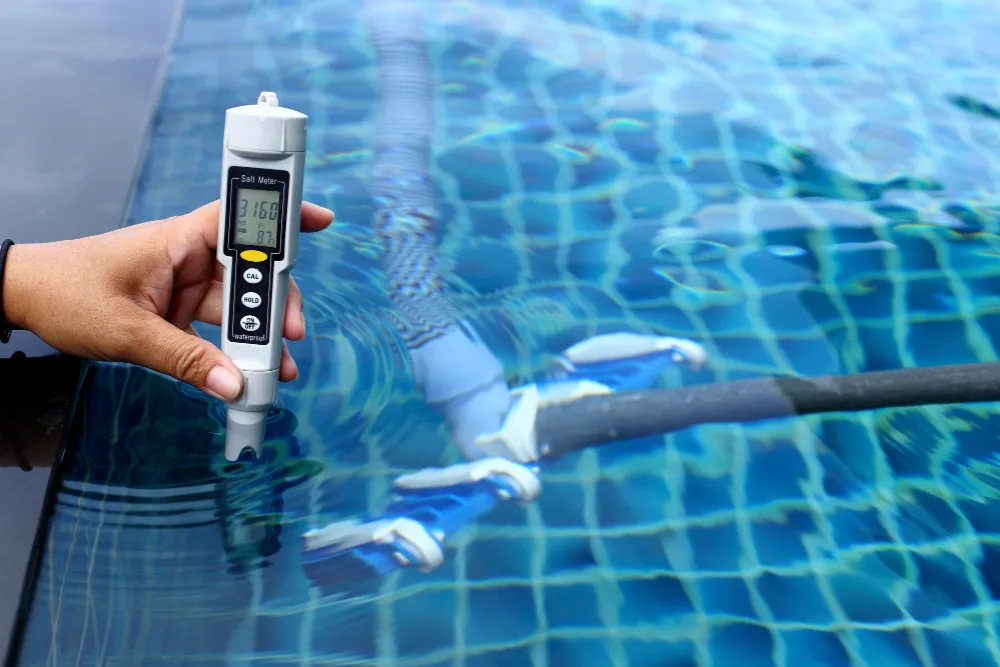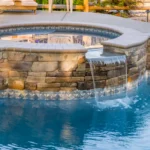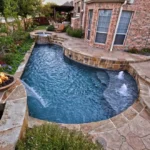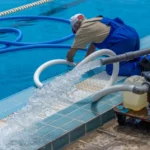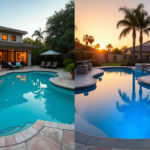Choosing between chlorine vs salt water pools ranks among the most important decisions you’ll make when building or upgrading your swimming pool. Both systems offer unique advantages, but understanding their differences in cost, maintenance, and performance will help you select the perfect option for your backyard oasis.
This comprehensive guide breaks down everything you need to know about salt water pool cost vs chlorine systems, how salt pools work, and the real-world considerations that matter most to pool owners.
Why Winterizing Swimming Pool Systems Matters
Winterizing swimming pool systems is critical for above ground pools. Unlike in-ground pools, they sit above the frost line and are more exposed to freezing temperatures.
Water expands about 9% when it freezes, putting pressure on pipes, equipment, and walls. Without proper winterization, you could face cracked equipment, burst plumbing, or structural pool damage.
Using a pool winterizer also helps prevent algae growth during the offseason. Clean, balanced water now saves money and time when reopening in spring.
Understanding How Each Pool System Works
Traditional Chlorine Pool Systems
Traditional chlorine pools rely on manually added chlorine chemicals to sanitize the water. Pool owners typically add liquid chlorine, chlorine tablets, or granular chlorine directly to the pool water. This process requires regular testing and adjustment to maintain proper chemical balance.
The chlorine works by releasing hypochlorous acid, which kills bacteria, algae, and other contaminants. Pool owners must monitor chlorine levels weekly and adjust them based on usage, weather conditions, and other factors.
How Salt Pools Work
Salt water pools use a chlorine generator (also called a salt cell) to produce chlorine from dissolved salt. The system adds salt to the pool water, typically maintaining levels around 3,000-4,000 parts per million. The salt cell then uses electrolysis to convert the salt into chlorine.
This process creates a continuous cycle where the chlorine sanitizes the water, then converts back to salt, ready to be processed again. The result is a steady supply of chlorine without the need for manual chemical additions.
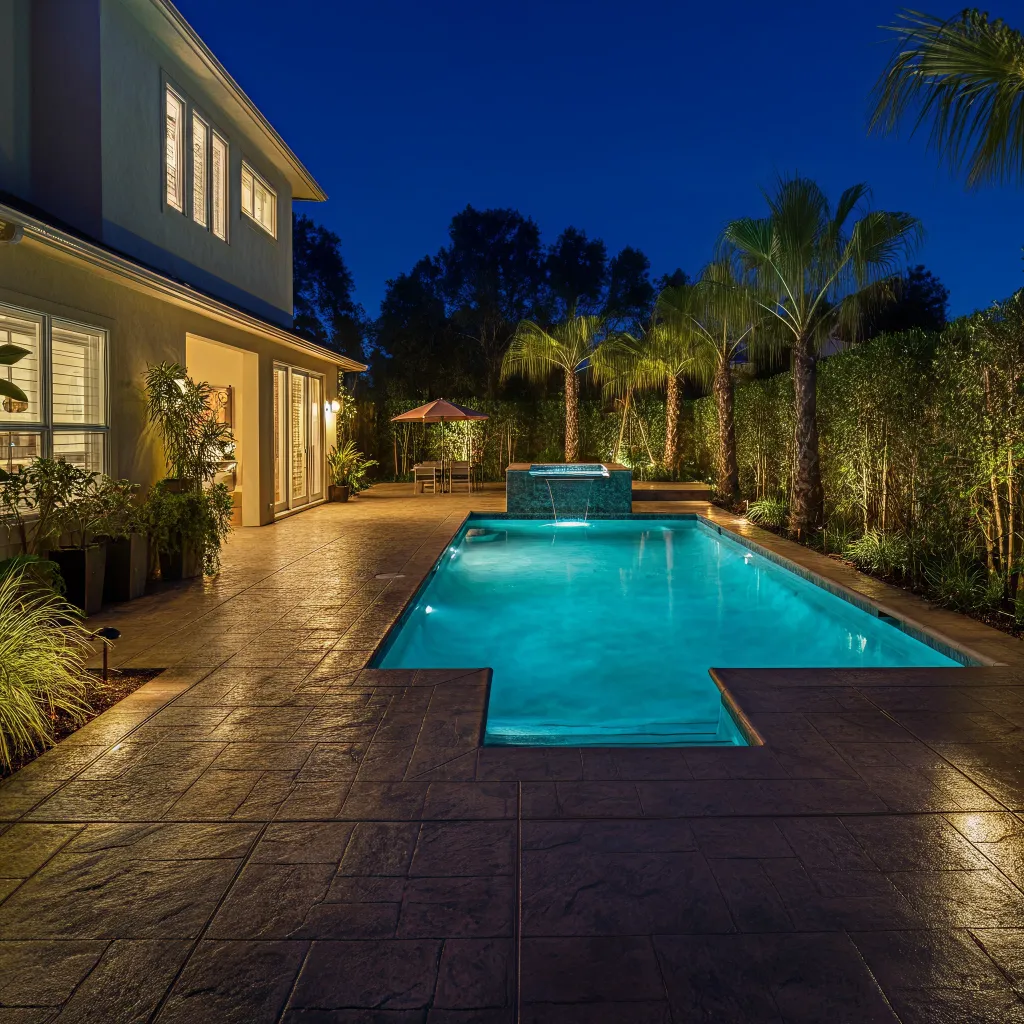
Salt Pool vs Chlorine Pool Cost Analysis
Initial Installation Costs
Traditional chlorine pools typically cost less upfront since they don’t require specialized equipment. The basic pool construction remains the same, with standard filtration and circulation systems.
Salt water systems require additional equipment, including:
Salt chlorine generator: $500-$2,500
Control panel upgrades: $200-$800
Initial salt supply: $50-$150
The total additional cost for salt water systems ranges from $750-$3,450 during initial installation.
Ongoing Operating Costs
Chlorine Pool Annual Costs:
Chlorine chemicals: $300-$800
pH adjusters and other chemicals: $100-$300
Testing supplies: $50-$100
Total annual cost: $450-$1,200
Salt Water Pool Annual Costs:
Salt replacement: $50-$150
Electricity for generator: $100-$300
Cell replacement (every 3-5 years): $200-$800 annually
Other chemicals: $50-$200
Total annual cost: $400-$1,450
Long-Term Financial Considerations
Salt water systems often provide cost savings over time, especially for larger pools or heavy usage situations. The automated chlorine production reduces labor costs and eliminates the need for storing and handling chlorine chemicals.
However, salt cells require replacement every 3-7 years, creating periodic major expenses. Traditional chlorine systems have more predictable ongoing costs but require consistent chemical purchases.
Maintenance Requirements Compared
Daily and Weekly Maintenance
Chlorine Pools:
Test water chemistry 2-3 times weekly
Add chlorine as needed
Adjust pH and alkalinity regularly
Shock treatment weekly during peak season
Clean skimmers and filters regularly
Salt Water Pools:
Test salt levels monthly
Check generator operation weekly
Monitor pH levels (salt systems tend to raise pH)
Clean salt cell quarterly
Standard filter and skimmer maintenance
Seasonal Maintenance Tasks
Both systems require similar seasonal maintenance procedures. However, salt water systems need additional winterization steps to protect the generator from freezing temperatures.
Salt pools also require periodic cell cleaning with muriatic acid to remove calcium buildup, while chlorine pools focus more on equipment storage and chemical balancing.
Water Quality and Swimming Experience
Water Feel and Comfort
Salt water pools create noticeably softer-feeling water that’s gentler on skin and hair. The lower chlorine concentration reduces the harsh chemical smell and eliminates the burning sensation often associated with over-chlorinated pools.
Traditional chlorine pools can cause dry skin, faded swimwear, and strong chemical odors when chlorine levels are too high. However, properly maintained chlorine pools provide excellent water quality without these issues.
Health and Safety Considerations
Both systems effectively sanitize pool water when properly maintained. Salt water pools maintain more consistent chlorine levels, reducing the risk of under-chlorinated or over-chlorinated conditions.
People with sensitive skin or chlorine allergies often prefer salt water systems. However, salt water isn’t suitable for everyone – those with certain medical conditions should consult their doctor before using salt water pools.
Equipment and Infrastructure Requirements
Essential Equipment for Each System
Chlorine Pool Equipment:
Standard pool pump and filter
Chemical feeding system (optional)
Testing kit or digital tester
Chemical storage area
Salt Water Pool Equipment:
Salt chlorine generator
Digital control panel
Salt-compatible pool equipment
Specialized testing equipment
Adequate electrical supply
Compatibility Considerations
Salt water can be corrosive to certain materials. Pool owners must ensure their equipment, including heaters, ladders, and light fixtures, are compatible with salt water. Some older pools may require equipment upgrades before converting to salt water.
The pool surface material also matters – certain stone types and metals can be damaged by salt water over time.
Chlorine to Salt Water Pool Conversion
Conversion Process Overview
Converting an existing chlorine pool to salt water involves several steps:
Equipment Assessment: Verify all pool equipment is salt-compatible
Generator Installation: Install the salt chlorine generator and control system
Electrical Work: Ensure adequate power supply for the generator
Water Chemistry: Balance the water and add the initial salt load
System Testing: Verify proper operation and chlorine production
Conversion Costs and Timeline
A typical chlorine to salt water pool conversion costs $1,000-$4,000, depending on pool size and required equipment upgrades. The process usually takes 1-3 days for professional installation.
Some pools require additional work, such as electrical upgrades or equipment replacement, which can increase costs and timeline.
Professional vs DIY Conversion
While homeowners can purchase salt chlorine generators online, professional installation ensures proper sizing, electrical work, and system integration. Improper installation can damage pool equipment or create safety hazards.
Professional installers also provide warranty coverage and ongoing support, valuable benefits for this significant investment.
Equipment and Infrastructure Requirements
Essential Equipment for Each System
Chlorine Pool Equipment:
Standard pool pump and filter
Chemical feeding system (optional)
Testing kit or digital tester
Chemical storage area
Salt Water Pool Equipment:
Salt chlorine generator
Digital control panel
Salt-compatible pool equipment
Specialized testing equipment
Adequate electrical supply
Compatibility Considerations
Salt water can be corrosive to certain materials. Pool owners must ensure their equipment, including heaters, ladders, and light fixtures, are compatible with salt water. Some older pools may require equipment upgrades before converting to salt water.
The pool surface material also matters – certain stone types and metals can be damaged by salt water over time.
Chlorine to Salt Water Pool Conversion
Conversion Process Overview
Converting an existing chlorine pool to salt water involves several steps:
- Equipment Assessment: Verify all pool equipment is salt-compatible
- Generator Installation: Install the salt chlorine generator and control system
- Electrical Work: Ensure adequate power supply for the generator
- Water Chemistry: Balance the water and add the initial salt load
- System Testing: Verify proper operation and chlorine production
Conversion Costs and Timeline
A typical chlorine to salt water pool conversion costs $1,000-$4,000, depending on pool size and required equipment upgrades. The process usually takes 1-3 days for professional installation.
Some pools require additional work, such as electrical upgrades or equipment replacement, which can increase costs and timeline.
Professional vs DIY Conversion
While homeowners can purchase salt chlorine generators online, professional installation ensures proper sizing, electrical work, and system integration. Improper installation can damage pool equipment or create safety hazards.
Professional installers also provide warranty coverage and ongoing support, valuable benefits for this significant investment.
Pros and Cons Summary
Salt Water Pool Advantages
- Softer, more comfortable water
- Automated chlorine production
- Lower long-term chemical costs
- Consistent sanitization
- Reduced chemical handling
Salt Water Pool Disadvantages
- Higher upfront costs
- Complex equipment requiring specialized service
- Potential equipment corrosion
- Higher electricity usage
- Salt cell replacement costs
Chlorine Pool Advantages
- Lower initial investment
- Simple, proven technology
- Easy to service and repair
- Flexible chemical control
- Wide availability of supplies
Chlorine Pool Disadvantages
- Regular chemical handling required
- Potential for harsh water conditions
- Storage requirements for chemicals
- More frequent water testing needed
- Variable operating costs
Your Next Steps to Pool Perfection
The choice between chlorine vs salt water pools ultimately depends on your budget, maintenance preferences, and swimming priorities. Both systems can provide years of reliable service when properly installed and maintained.
Consider scheduling a consultation with experienced pool professionals who can evaluate your specific situation and provide personalized recommendations. They can assess your current pool setup, discuss your goals, and provide accurate cost estimates for either system.
Ready to make the best choice for your backyard oasis? Contact a trusted pool professional today to explore your options and start planning your perfect swimming experience.

